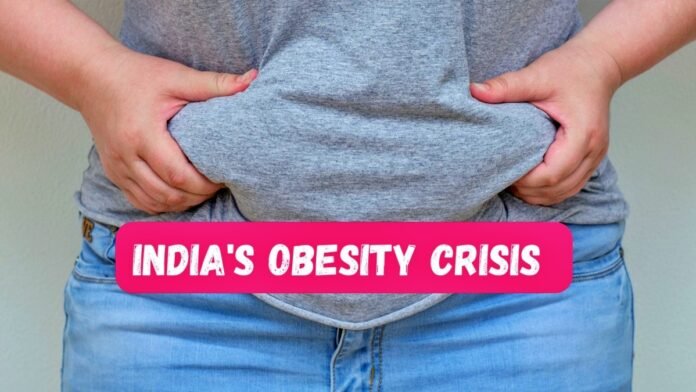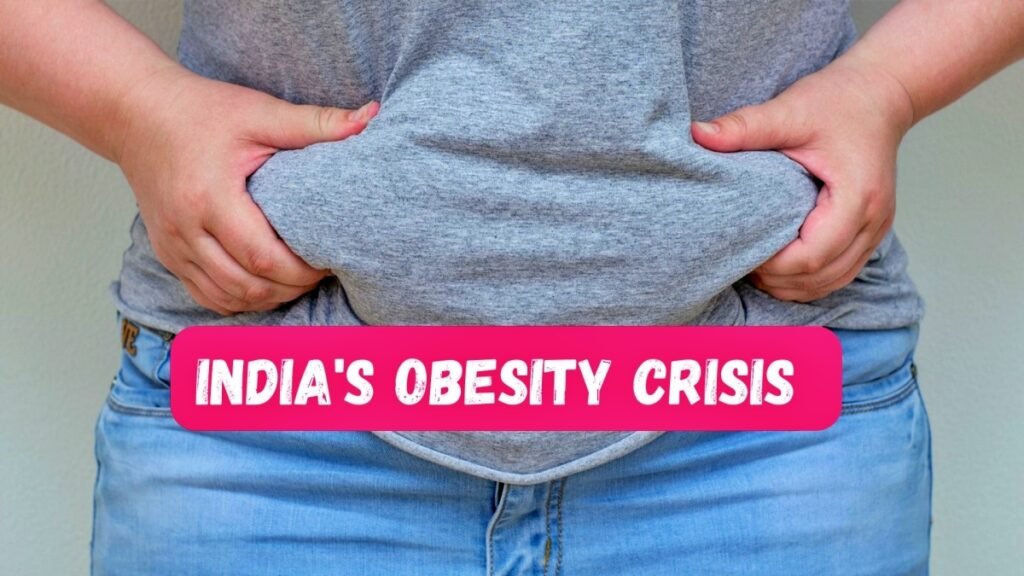
New Delhi: India, a country that is already grappling with the burden of non-communicable diseases such as diabetes, heart attacks, and strokes, is now facing another major health challenge: obesity. According to a survey done by Lancet, a medical journal, India has millions of overweight men, women, and children, and is among the top three countries in the world on the obesity curve, along with the US and China.
The survey, which was published in March 2024, revealed alarming rates of obesity in Indians, with nearly 80 million of them, including 10 million in the age bracket of 5-19 years, being obese. The report also highlighted the global trend of obesity among children and adolescents, which has increased by more than ten times in the past four decades.
The survey also showed that India’s obesity rate increased by 94% among women in 188 countries from 1990 to 2022, making it one of the fastest-growing regions for obesity in the world. The report attributed this rise to various factors such as urbanization, sedentary lifestyle, lack of physical activity, poor nutrition, and socio-economic disparities.
Key Highlights of the Report
The report, which was based on data from 200 countries and territories, presented some key findings about the prevalence and trends of obesity in India. Some of the main highlights are:
- The study found that in India, obesity in children between the ages of 5 and 19 has gone up from 0.4 million in 1990 to 12.5 million children in 2022, an increase of more than 30 times. This means that one in every 20 children in India is obese, which can have serious implications for their health and well-being in the future.
- Obesity among women over the age of 20 has gone up manifold from 2.4 million women in 1990 to 44 million in 2022, an increase of more than 18 times. This means that one in every 15 women in India is obese, which can increase their risk of developing chronic diseases such as diabetes, cardiovascular diseases, and some cancers.
- 26 million men in the same age group were found to be obese in 2022, while in 1990, only 1.1 million men were obese. This means that one in every 20 men in India is obese, which can also affect their health and quality of life.
- India ranks 182 among 197 countries for the prevalence of obesity in women and 180 for men in 2022. The country ranked 174 in the world for both girls and boys. This shows that India is lagging behind many other countries in tackling the obesity epidemic, and needs to take urgent action to prevent further deterioration of its public health.
- The study also points to the severe undernutrition in India, which is another side of the malnutrition problem. The country has the highest number of underweight girls globally and the second-highest for boys. In 2022, around 35 million girls and 42 million boys aged 5 to 19 were underweight, a decrease from 1990. Among adults, the percentage of underweight women dropped from 41.7% to 13.7%, and for men, it decreased from 39.8% to 12.5% in 2022. This shows that India still has a long way to go to achieve optimal nutrition for its population, and needs to address both the underweight and overweight issues simultaneously.
What is Obesity and Why it is an Important Health Indicator
According to the World Health Organization, obesity is an abnormal or excessive accumulation of fat in the body that can lead to health risks. A body mass index (BMI) over 25 is considered overweight while over 30 is obese. BMI is a measure of weight relative to height, and can be calculated as weight in kilograms divided by height in meters squared.
Obesity is an important health indicator because it is associated with a higher risk of developing various diseases and complications, such as:
- Type 2 diabetes, is a condition where the body cannot use insulin properly to regulate blood sugar levels. Diabetes can lead to complications such as kidney failure, blindness, nerve damage, and amputation.
- Cardiovascular diseases are diseases of the heart and blood vessels, such as coronary artery disease, heart attack, stroke, and heart failure. Cardiovascular diseases can cause chest pain, shortness of breath, weakness, and death.
- Some cancers, such as breast, colon, endometrial, and kidney cancer. Cancer is a disease where abnormal cells grow and spread uncontrollably and can damage organs and tissues.
- Osteoarthritis is a degenerative joint disease that causes pain, stiffness, and reduced mobility. Osteoarthritis can affect the knees, hips, spine, and other joints, and can limit daily activities and quality of life.
- Sleep apnea is a disorder where breathing stops and starts repeatedly during sleep. Sleep apnea can cause snoring, daytime sleepiness, headaches, and increased blood pressure.
- Depression, is a mood disorder that causes persistent sadness, loss of interest, and low self-esteem. Depression can affect the mental and emotional well-being of a person and can interfere with their social and professional functioning.
Obesity can also have a negative impact on the social and economic aspects of a person’s life, such as:
- Discrimination, stigma, and bullying are forms of unfair treatment and harassment based on a person’s weight or appearance. These can affect a person’s self-confidence, self-esteem, and mental health, and can lead to isolation, anxiety, and depression.
- Reduced productivity and income, are the consequences of obesity-related health problems and absenteeism. Obesity can impair a person’s ability to work efficiently and effectively and can reduce their earning potential and career opportunities.
- Increased healthcare costs are the expenses incurred by the individual and the society for the prevention, diagnosis, and treatment of obesity and its complications. Obesity can increase the demand for health care services and resources and can strain the health care system and the economy.
Why Women are More Obese than Men
The survey by Lancet showed that women in India are more obese than men, and that the gap between them has widened over the years. There are several factors that can explain this gender disparity, such as:
- Socio-cultural factors are the norms and expectations that influence a person’s behavior and choices. In India, women often face social and cultural barriers that limit their access to education, health care, and employment, and that influence their dietary and physical activity patterns. For example, women may have less decision-making power and autonomy over their health and nutrition and may prioritize the needs of their family members over their own. Women may also face gender-based violence and discrimination, which can affect their mental and emotional health and well-being.
- Biological factors are the natural and genetic differences that affect a person’s physiology and metabolism. Women have a higher percentage of body fat than men and tend to store fat in the lower body, such as the hips, thighs, and buttocks. Women also undergo hormonal changes during their life cycle, such as puberty, pregnancy, lactation, and menopause, which can affect their weight and appetite. Women may also have lower basal metabolic rate (BMR), which is the amount of energy the body uses at rest, and lower muscle mass, which is the amount of muscle tissue in the body. These factors can make it harder for women to lose weight and maintain a healthy weight.
- Behavioral factors are the habits and practices that affect a person’s lifestyle and health. Women may have different dietary and physical activity patterns than men, depending on their preferences, availability, and affordability. For example, women may consume more processed and high-calorie foods, and fewer fruits and vegetables, due to convenience, taste, and cost. Women may also engage in less physical activity, due to lack of time, space, safety, and social support. Women may also have more stress and emotional eating, due to their multiple roles and responsibilities, and their coping mechanisms.
How to Stop Obesity, Control Diet?
Obesity is a complex and multifaceted problem that requires a comprehensive and holistic approach to prevent and manage. There is no one-size-fits-all solution for obesity, and each person needs to find a suitable and sustainable strategy that works for them. However, some general principles and guidelines that can help stop obesity and control diet are:
- Adopt a balanced and nutritious diet, which is a diet that provides adequate and appropriate amounts of energy, protein, carbohydrates, fats, vitamins, minerals, and water for the body’s needs. A balanced and nutritious diet can help prevent and treat obesity and its complications and can improve the overall health and well-being of a person. Some tips for a balanced and nutritious diet are:
- Eat a variety of foods from different food groups, such as cereals, pulses, fruits, vegetables, milk and milk products, meat and eggs, and fats and oils. This can help ensure that the body gets all the essential nutrients it needs, and can also provide variety and enjoyment to the diet.
- Eat in moderation and avoid overeating, which is eating more than the body needs or can use. Overeating can lead to excess calorie intake and weight gain, and can also cause indigestion, bloating, and discomfort. To avoid overeating, one can follow some tips such as:
- Eat slowly and chew well, which can help the body digest the food better, and can also help the brain register the feeling of fullness and satisfaction.
- Eat at regular intervals and avoid skipping meals, which can help regulate the appetite and blood sugar levels.














































